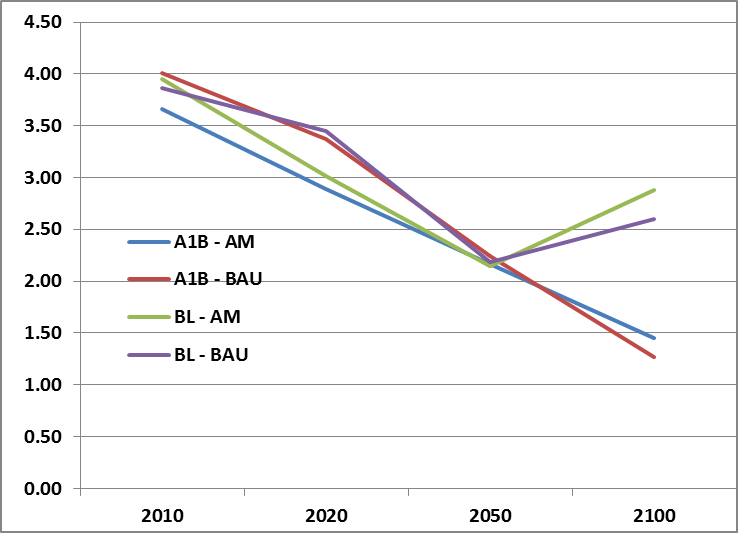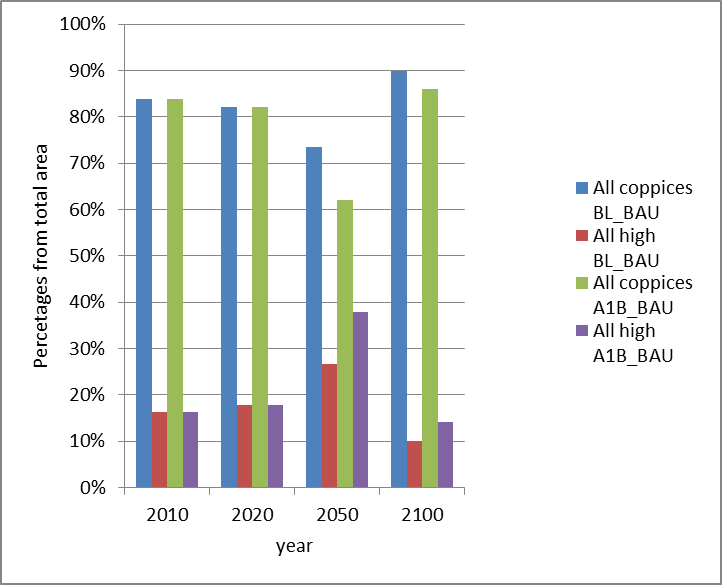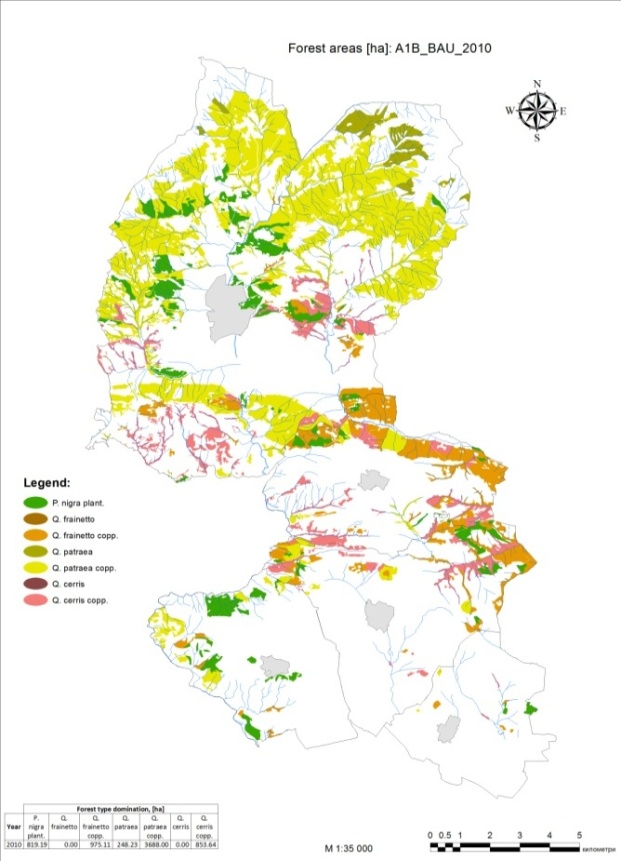The assessment of tree species sensitivity to climatic changes in the case study distinguishes three key ecosystem processes (a) growth, (b) regeneration and (c) mortality of trees with regard to three time horizons: (i) short-term (up to 2020), (ii) mid-term (2020 to 2050) and (iii) longterm (2050 to 2100).
1) Growth
All tree species in the region will actually physiologically fall out because of the drier climate and the water supply on most sites is a limiting factor (current precipitation levels will decrease up to 120 mm per year and T will rise up to 3.5 degree C which increases the evapotranspiration). The droughts and less favorable growing conditions during the growing seasons cause substantial decrease of the mean annual increment of the forest stands (fig. BG-1).

Fig BG-1. Average annual increment (cub.m/ha/year) simulation data for the forest case-study area Panagyurishte, by two climate scenarios (A1B& BL) and both BAU and AM management scenarios
2) Regeneration
In the short-term scale, not severe changes are expected. Mid-term seed regeneration will be still possible for most of the oak coppice stands (which is the important management goal). In long-term, the ecological conditions will worsen seed regeneration since the mature oak trees need favorable climatic condition to produce vital acorns. Young seedlings of seed origin will be more sensitive to drought stress and will be shifted by the young sprouts, which ability to provide more water through their old and well developed root system is higher (fig.BG-2).

Fig.BG-2. Distribution of forest stands in case study by origin for the two climatic scenarios (A1B & BL) following BAU management scenario.
3) Mortality
Due to the warmer and drier conditions some shortening of the current vegetation period will occur and the more xerophytes tree species will be less vulnerable. More valuable, but mesophyte Sessile oak (Q.petrea) will be most affected by long lasting, dry conditions. Warmer and open winter could provoke earlier blossoming of trees’ buds which could cause damage from later frosts. Constant short vegetation period will lead to a decrease of growth of the existing trees and a reduced stand’s canopy. These will increase the risk of epidemic outbreaks caused by insects, fungies and forest fires as well.
The Hungarian oak (Q.frainetto) is the most drought-resistant species in the case study area, followed by Turkey oak (Q.cerris). An important difference between them is that H.oak has a relatively slower growth in the beginning (lag in mixed stands) and reaches a mature phase at least 15-20 years later than Turkey oak.These leads to a permanent increase of the share of the more drought-tolerant and adaptive Turkey oak, which gradually replaces Sessile and Hungarian oaks during all periods of time (fig.BG-3 and BG-4).
For pine plantations the risk of forest fires will increase substantially. Reduced precipitation and warmer temperatures may positively affect the conditions for Thaumetopoea pityocampa Schiff. and thus deteriorate the growing conditions for pines. From the other side, the Austrian pine (Pinus nigra) is competitive in dry soils.

Fig BG-3. Species and origin dynamics of forest stands in the the case study Panagyurishte by moderate climate scenario A1B and BAU management (Year 2010).

Fig BG-4. Species and origin dynamics of forest stands in the the case study Panagyurishte by moderate climate scenario A1B and BAU management (Year 2100).
More of the pine stands should be harvested in mid-term run and pine will regenerate successfully together with some oaks. Looking long-term, about half of these future mixed stands will not be dominated by pine.
Flowering ash (Fraxinusornus) and Eastern hornbeam(Carpinusorientalis) will be more often a part of the tree species composition as provisional species.
For a summary of the tree species’ sensitivities please see Table BG-1.
Table BG-1: Mid- to longterm tree species’ sensitivities towards projected climate change for the three forest ecosystem processes. (+ increase, ~ no change, – decrease)
|
growth
|
regeneration
|
mortality
|
||||
| Tree species |
2020-2050 |
2050-2100 |
2020-2050 |
2050-2100 |
2020-2050 |
2050-2100 |
| Turkey oak –coppice |
~ |
— |
++ |
+ |
~ |
+ |
| Turkey oak – high |
– |
— |
~ |
– |
~ |
– |
| Sessile oak – coppice |
– |
— |
+ |
~ |
~ |
— |
| Sessile oak – high |
— |
— |
– |
— |
– |
— |
| Hungarian oak– coppice |
– |
— |
+ |
+ |
~ |
– |
| Hungarian oak– high |
– |
— |
~ |
— |
– |
— |
| Austrian pine |
– |
— |
~ |
+ |
~ |
— |
| Flowering ash |
~ |
– |
~ |
+ |
~ |
– |